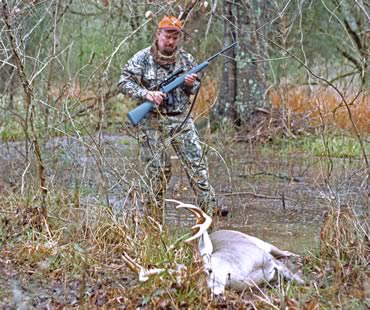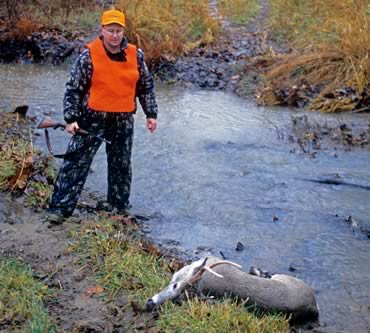Windy days can be miserable in the stand, but wind can help you overcome a deer’s defenses.
Michael Haviland wanted to make it clear that he’d be ready whenever I decided to pull the trigger. The then-24-year-old videographer was on the viewfinder end of a pro-model video camera, braced on a limb over my right shoulder a dozen feet up an oak tree on that windy, December morning. The southeast Kansas gusts nudged our side-by-side treestands, providing a bit of concern that holding steady on the long-tined 8-pointer at more than 200 yards wouldn’t be easy.
It was the first morning of a four-day hunt in the rolling, scrubby Kansas landscape, some 20 miles north of the Oklahoma border.
“Weather’s supposed to turn really bad tomorrow,” said Haviland after again studying the buck through the telephoto lens. “Supposed to get some rain or snow, too.”
It was obvious he wanted me to shoot. The talented, young videographer had first zoomed in on the giant buck as a hazy sunrise formed behind it. Earlier in the week, he’d gathered most of the other footage needed for a new Lohman Game Calls video — everything, that is, but the final shot.
Drawing a grunt tube from my jacket, I thought perhaps I could lure the feeding buck closer with a few enticing, baritone burps. On days with favorable or calm air movement, I’ve watched open-field bucks at 200 yards or more react to loud grunting. But windy conditions tend to minimize a mouth call’s effectiveness. Trying to blow or inhale any louder has its limits, and that was the case when I tried to push the volume a bit too much, resulting in a comical sound usually associated with a New Year’s Eve party toy.
 Although the increasing wind had played a role in my decision to temporarily pass on the handsome buck, Haviland’s weather report was on target. The forecast called for a cold front to move through, bringing with it stiff wind, rain and snow squalls. Several minutes later, the buck and six does trotted to the edge of the woods and disappeared. I crossed my fingers in hope of their return — when the wind stopped blowing.
Although the increasing wind had played a role in my decision to temporarily pass on the handsome buck, Haviland’s weather report was on target. The forecast called for a cold front to move through, bringing with it stiff wind, rain and snow squalls. Several minutes later, the buck and six does trotted to the edge of the woods and disappeared. I crossed my fingers in hope of their return — when the wind stopped blowing.
Using the Wind
Of all the types of weather deer hunters face each season, heavy wind is the least favorite. But I’ve also learned that the conditions inherent on such days don’t always tip the scales for deer. You can capitalize on those big blows, which drive deer into cover — and many hunters back to bed.
Regardless of the persistent and predictable winds that slice across the Midwest’s whitetail country, deer there are affected like deer everywhere: When winds cut down on the effectiveness of their fine-tuned senses of sight, scent and sound, their instinct is to head to places where they can rely on familiar protective cover in which to hide and wait out the storm. Or they do just the opposite and bed in relative openness, perhaps just below a ridge or bench where wind velocities are less and their vision is enhanced.
“They’ll first look for places out of the wind, and that’s where you need to look,” advised Brad Harris, formerly of the Lohman staff, who invited me to join him for the Kansas gathering. “When the wind’s whipping, I don’t even think about getting into a treestand. I’ll stay on the ground and use the wind, and the movement and noise it creates, to my advantage. They (deer) might not want to move around, but you should.”
Wind and Scents
Under big-blow conditions, human scent will not necessarily take what you consider the obvious route to the nose of a downwind deer. Even 30 mph-plus breezes, like the one Haviland and I encountered from our twin treestands that December morning, will not carry scent in any predictable path. After the big buck departed that same morning, six does moved up from behind but did not detect us, even though we were only 15 yards directly upwind and about 20 feet over their heads.
 However, as the deer passed to our immediate left, the lead doe suddenly raised her nose, locked her ears, snorted and turned tail, leading the others in a hasty departure. Seconds later, I tested the wind with a few strands of milkweed silk I carry for such occasions and noted the abrupt angle at which the plant fibers traced the course of the current. The cottony seed-carriers drifted overhead, then dropped abruptly, changing course and moving back past the deer and us in the direction from which they first appeared.
However, as the deer passed to our immediate left, the lead doe suddenly raised her nose, locked her ears, snorted and turned tail, leading the others in a hasty departure. Seconds later, I tested the wind with a few strands of milkweed silk I carry for such occasions and noted the abrupt angle at which the plant fibers traced the course of the current. The cottony seed-carriers drifted overhead, then dropped abruptly, changing course and moving back past the deer and us in the direction from which they first appeared.
“We get caught because of our scent so many times that we just assume we’ll be detected easier on windy days, but that’s not really true,” Harris said back at camp that evening. “When you’re in heavy cover or on a bench or saddle or even down in a draw, the wind will be channeled in different directions. In some cases, the windier it is, the better.”
Dead Giveaway
Motion is also effectively masked by wind. Even rookie hunters know that errant movement is a dead giveaway on still days. Move, and a deer will see you. If a deer moves, you will see it. On windy days, however, the constant motion of leaves and other vegetation makes it more difficult for both hunter and hunted to pick out the flick of an ear or the movement of a hand or hat. The advantage often goes to the hunter.
Such was the case that December morning when our gamble that the video buck would return paid off. He’d disappeared with his does an hour earlier, and upon his return seemed to ignore the gusty wind, drizzle and snow flurries.
“On three, I’m gonna shoot,” I whispered to Haviland’s delight after another minute of tape had been exposed. When the buck turned broadside, I settled the crosshairs behind the front leg and squeezed the trigger of the Remington .270. Five minutes later, we found the buck at the end of a splattered blood trail.
Back at camp that evening, Harris ran his fingers over the rack and offered that the handsome buck would measure about 139 inches and carry a 19-inch spread. Not bad for a windblown whitetail.
The message here is that wind and threatening weather need not be deterrents to quality deer hunting. Hunters who flick on the local, all-night weather report before heading out can head to some otherwise unlikely habitats to which bucks and does instinctively navigate — when the wind blows.
Read Recent Articles:
• Where Do All the Big Bucks Go?: Be prepared to get cut and dirty if you want to go where the giants roam.
• Lost and Found: How a top-10 Pa. buck almost never made it to the hunter’s wall.
• Fetching Sheds: Antler hunting is more fun with man’s best friend.
This article was published in the November 2008 edition of Buckmasters Whitetail Magazine. Join today to have Buckmasters delivered to your home.